Ismail Merchant's The Mystic Masseur has been filming on location in
Trinidad for the past month-and-a-half. In this feature, part of a series from the frontlines of the emerging movie, Assistant
Editor Nirshan Perera brings to life a day on Masseur's
sets.
Monday, February 19, 2001: Day 37, 6.30 am
It's another long day of office work for Mary Murphy and Nasheed Faruki. Their time in Trinidad is far removed from the
hustle and glamour of frontline film work. But without their tireless behind-the-scenes labor, the entire project would grind to
a halt.
Murphy and Faruki run the central production office for The Mystic Masseur. The unassuming house they have
hired on the outskirts of Trinidad's capital, Port of Spain, functions as the hub for all of Masseur's filming
on the island. Most days, the coffee machine in the kitchen will begin brewing well before the rest of the crew's alarm clocks
even go off. And, even after the crew has called it a day, the lights in this house will stay on well into the night
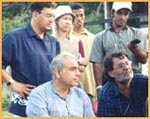
Ismail Merchant, cameraman Ernie Vincze and the rest of the crew
|
Each morning, at 6:30 on the dot, Murphy and Faruki begin pushing paper in paradise. First, they make sure the pick-ups run
smoothly and all the actors and crew get to the set on time. Then, dozens of faxes and e-mails await their attention. There are
suppliers and shipping agents to deal with, to ensure that film canisters and the mail get out and crucial supplies get in.
Marketing plans need to be firmed up, post-production work has to be coordinated. And at the end of the day, the call sheet
-- the all-important production schedule for the next day -- must be made and delivered to everyone involved in the movie.
8.30 am
Three 30-foot trucks and over 10 cars roll up to a remote location in Santa Cruz, a rural town near Port of Spain. As the
crackle of the cicadas increase to fever pitch, the cast and crew yawn and stretch their legs. More than 50 extras -- locals
who will play bit parts in today's scenes -- hitchhike on the dusty road or arrive by bus.
Hopefully, five scenes will be shot today. On the screen, they may last just five minutes. The location is an ambling colonial
style house, built over 150 years ago. Shooting will proceed on the grounds in and around the house.
In the first scene of the day, the main character of the movie, Ganesh, played by Aasif Mandvi, will drive up to a political rally
being held in his honor. He will then be greeted by Jimi Mistry's character, Partap, and a large crowd of followers and
well-wishers.
But it will take several hours to physically set up the scene and coach and costume the extras. And, beyond that, there are a
host of other things to be done. Electricians, for instance, have to unload the equipment and connect everything to portable
generators. The caterers must put up their stalls for the day to sustain the 80-odd people on the set. And police officers have
to get ready to control traffic on the thoroughfare adjoining the set.
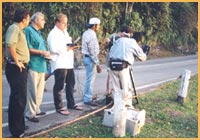
Merchant, producer Richard Hawley (white shirt) and the crew
|
The camera must also be set up to roll back and forth on 40 feet of rails. Aaron Anawalt, a veteran of Merchant Ivory's
production team, coordinates the construction of the tracks. Long sections of metal piping are laid on top of wooden boxes
and wedges that are form-fitted to the uneven contours of the ground.
Ismail Merchant wistfully hopes the camera will begin rolling by noon at least.
11.40 am
Tempers flare. Producer Richard Hawley chews out two production assistants for not protecting his immaculate take.
Merchant is the director, but Hawley supervises the scenes with an eagle eye.
"Everyone reset! Let's do it again," he barks. A wide, drawn-out shot -- comprising more than a minute of continuous filming
(an eon in production time) -- is destroyed by outsiders waltzing into the camera's
line of sight..
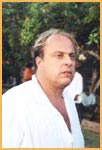
Producer
Richard Hawley
|
"What's going on here?" Hawley growls. "Get them up here!"
He gives the production assistants, Nirad and Damien, explicit instructions to shoo strangers away, relaying potential
disturbances to the camera crew through two-way radios.
"Come on, lock it up," Hawley says, wiping the sweat from his brow.
12.05 pm
Merchant is dissatisfied with the second take. An extra has looked straight into the camera's eye and a political placard
has been thrust up too sharply.
"Say two Hail Marys, here we go again," jokes assistant director Vince Gonzales.
As the crew sets up to redo the scene, Jimi Mistry holds up a small portable fan to keep the make-up from melting off his
face.
12.30 pm
Tweaking the screenplay on a director's whim, Ismail Merchant wants the crowd of followers engulfing Mandvi to
shout "Ganesh ki Jai!" instead of "Long live Ganesh!" Since the scene has already been shot, the extras cluster
around soundman Peter Schneider, who's holding a long drooping microphone and is weighed down by about 30 lbs of gear,
to record the chant. In a small bit of movie magic, their voices will be overlayed on top of the original sound in the recorded
scene when the film hits the editing studio.
1.00 pm
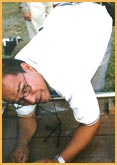
Assistant Director
Vince Gonzales
|
The same scene is redone from a slightly different angle. Four handpicked extras will troop behind and in front of the camera
this time to add depth to the shot. Jeremy Ramroop, a 16-year-old high school student; Kurtis Mohammed, an electrician;
Ivan Mohammed, a factory foreman; and Edwin Norbert, a stone mason, get ready for their five seconds of fame. In a quick
rehearsal, they execute the scene flawlessly.
"Can I take you guys back to Hollywood with me?" Vince Gonzales quips.
1.30 pm
Film production comes to a standstill, pending the arrival of 50 buffaloes. In the next scene, this herd will cross in front of the
car carrying Mandvi to the political rally.
"Where are the buffaloes?" asks an irritated Merchant.
"They'll come like clockwork," jokes Hawley.
"We're on buffalo watch! Buffalo watch!" chants Ernie Vincze, the principal cameraman.
1.45 pm
The buffaloes have finally arrived, but the herder is wearing a very modern and fashionable sleeveless black T-shirt. The
setting of the movie, meanwhile, is Trinidad in the 1950s. Gonzales calls wardrobe to suit the herder up in more vintage
garb.
1.50 pm
Warily, the buffaloes approach the camera. Hawley instructs the cast and crew not to move. He is afraid of a
stampede.
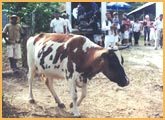
The buffalo watch
|
"This is a health and safety warning," he says.
The local extra, Ivan Mohammed, tells me in an aside: "You know, I don't think they had buffaloes in Trinidad in the 1950s."
Hopefully, the critics won't notice that little detail.
1.52 pm
The buffaloes continue to approach slowly, eyeing the camera suspiciously. Their herder, who is perhaps in his 70s,
relentlessly prods them on until they've all crossed in front of the camera. Then, ignoring frantic warning shouts from the crew,
he walks directly in front of the camera.
"Shit!" Hawley says. It's hard enough regrouping 50 untrained local extras -- try 50 buffaloes!!
Merchant, trying to remain calm, says: "We'll just clip the old man out in editing and retake the shot of the car going
downhill."
"That was a million-dollar shot," he tells me, glowing. "I did it just for him," he says, pointing to Hawley, "so he could see a
herd of buffaloes."
2.15 pm
Mandvi is showcasing a war wound. He tried to jump over a wall and nicked his left shin in the process. The small
scratch has bled through his kurta bottoms slightly. "All this madness crammed into one day!" he says.
"No more slippin' and fallin'," warns Cintra Mangri, the registered nurse on set. "Otherwise, I'll carry you around for the rest
of the day."
2.20 pm
A small, relatively simple scene involving Nirad Tewarie, a production assistant on the set, is quickly set up and shot. Nirad
plays a champion bicyclist in the movie, who has been cured of a sickness by Ganesh, Mandvi's character. In the
scene, Nirad is given a wreath of leaves and holds his hands high over his head in victory. The three second clip is shot
smoothly, without any retakes.
2.30 pm
The cast and crew break for lunch: Spanish fried rice, lamb curry and jerk chicken. An ardent chef, Ismail Merchant's movie
set is known for its good food. After eating, he heads into the house for a small siesta.
3.30 pm
Vince Gonzales begins hammering out the next day's call sheet. The densely scripted page, composed by Gonzales each day,
basically lays out the battle strategy for each day of shooting. In minuscule detail, the two-sided sheet tells people what is
needed for the filming, who is needed, where and when and for how long. It is the logistic mainframe of each day's
production.
4.00 pm
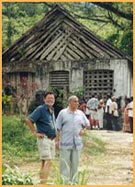
Merchant and cameraman Ernie Vincze
|
Ernie Vincze and Ismail Merchant discuss the logistics for the third scene of the day. It's near the main road so traffic needs
to be halted for at least 100 yards in either direction. In the scene, actors Aasif Mandvi, Jimi Mistry and Sanjeev Bhaskar,
followed by a large crowd, will walk down a side road towards the camera, get into a car and drive off. The camera will be
handheld throughout the scene, so it needs be shot with as little retakes as possible.
4.30 pm
The take begins, but the crowd proceeds too far down the road.
"I didn't want them to come this far!" yells Ismail Merchant, as the extras regroup for another take.
4.35 pm
The pent-up traffic on the main road is allowed to pass through while the crew assembles for another take. For a few
minutes, the set is filled with the blaring calypso and soca beats from the stereos of the 30-odd cars and trucks that roll by.
"Hey, mon, I wanna be an actor!" shouts one dreadlocked Rastafarian.
4.40 pm
The road is blocked off once more. The retake begins. The crowd marches down the road after the three actors, miming
shouts and cheers and thrusting their hands up in the air. The silence of this purely visual spectacle is eerie but necessary: The
three principal actors in the scene are conversing and the sound mike must pick up their words only.
4.45 pm
The stubborn car stalls and Mandvi forgets one of his lines. Merchant calls for yet another arduous retake.
5.00 pm
Take 3. Again, the crowd comes too close to the three actors. Hawley calls for another retake. "Nobody! Does!
Anything! Until! Sanjeev! Gets! In! The! Car!" he yells, angrily punctuating each word.
5.15 pm
Take 4. Once again, the crowd closes in too quickly.
"We've got blemishes, but it's better," declares cameraman Vincze. He reviews the take with Merchant on a
small handheld monitor. Merchant praises the lighting conditions, but worries about a house that features too prominently in
the background of the shot. The house has already been seen in several other scenes and Merchant is worried that, if viewers
remember it, the scene will not convey a different locale. Richard Hawley offers to move a car in front of the house to
obscure it.
"It could be anywhere, only you and I know it's the same house," Vincze says.
"Well, let's do it again anyway," says Merchant.
5.25 pm
Take 5. The cameraman stumbles on a loose patch of soil. The entire take is scrapped. Thankfully, Take 6 is a keeper.
5.30 pm
The entire shot is now to be taken from another angle. The camera will follow actor Sanjeev Bhaskar as he gets into the car
from the rear.
5.50 pm
The crowd of extras gather around soundman Peter Schneider again to shout "Ganesh ki Jai!" and "Long live
Ganesh!" Once again, in the editing stage, the recording will be dubbed into scene at selected
moments.
6.00 pm
The last two scenes of the day are nighttime shoots, so the cast and crew take a break and wait for the sun to go down. The
wardrobe crew begins the long process of undressing the 50 exhausted local extras who are done for the day.
The fourth and fifth scenes will take place in the interior of Mandvi's car. The lighting and camera crew begin their
preparations. The rear and passenger windows are blocked and darkened from the inside with black cardboard. Meanwhile,
the camera is fixed inside the car over the gearshift, pointing straight back to the rear seat. While the scenes are being shot,
the crew will gently rock the car back and forth to mimic motion. The lighting crew will also pass handheld external lights over
the dark cardboard to mimic the glare of lights
from other cars and passing streetlights.
6.55 pm
Mandvi and Mistry rehearse the scene. Mandvi's character, Ganesh, will ask Partap, played by Mistry, to be his
top aide. During the rehearsal, soundman Schneider notices that the camera is squeaking on the car's leather seats as it
moves between the two actors. He calls for a blanket to be laid down beneath it to muffle the sound.
7.05 pm
Crew member Ben Spencer organizes the weekly cast lottery. On Mondays, everyone on the sets of The Mystic
Masseur writes their name on a $ 20 Trinidad note (about US $ 3.30) and puts it in a large bag. When the day's filming
is done, one note is drawn and its owner gets the whole bag. In the last month-and-a-half of filming, the pot has been as
much as $ 1,000 (in Trinidad dollars). Past winners have included Merchant, who borrowed his $ 20 note from Third
Assistant Director Suraj Varma. When he won the $ 1,000 pot, he returned $ 60 to Varma. "He told me, 'When you invest
money in me, you get three times that,'" says a laughing Varma.
Meanwhile, Spencer and Mistry place a side bet. If Mistry wins the pot this week, he has to play a game of pool
with Spencer. If he wins the game, Spencer will give him double the pot. If Spencer wins, Mistry owes him nothing.
7.25 pm
Night has fallen. Take 1 of the next scene. Cameraman Vincze quickly calls for a retake. The car is being shaken too
much, he says. What is supposed to be a gentle shaking motion actually looks more like a earthquake. Also, the lights being
reflected into the car from the outside are being waved about too much and too fast. "Leave it on longer and only pass them
once," he tells the lighting crew.
7.30 pm
Merchant calls for another retake, saying Mandvi hesitated before saying one of his lines. Take 2 goes smoothly,
though, and the crew begins setting up for the last shot of the night.
In the fifth and last scene, Mandvi and his driver, played by local Trinidad actor Dinesh Maharaj, are alone in the car.
Mandvi's character, Ganesh, has just decided to move from rural Trinidad to the bustling capital of Port of Spain. Maharaj
speaks to Mandvi for about 30 seconds, telling him the country folk will be sad to see him go, but it's a wise decision.
As Mandvi goes to wardrobe to change into a Western-style suit, the camera crew removes the camera from above the
gearshift and mounts it on the hood of the car, staring inward.
8.00 pm
Take 1. Maharaj's delivery is flawless, but Merchant inexplicably calls for another take.
8.10 pm
Take 2. "Good!" Merchant declares. The exhausted cast and crew give out a collective sigh of relief.
8.15 pm
Same scene, different angle. This time, the camera is trained on Mandvi as Maharaj talks. Take 1 begins and is
quickly halted by Vincze. The shaking of the car is too regular, he complains. On film, it doesn't look like it is really
moving.
8.18 pm
"Cut! Very good," says Merchant, signaling the end of a long day's filming.
8.20 pm
Hawley calls for entire cast and crew to assemble. He thanks everyone for a hard day's work and passes out the
schedule for the next day.
Finally, the weekly lottery bag is brought out amid loud cheering. Crew member Shenaz Vahanvaty dips her hand in and
plucks out a bright purple note signed "Fast Jimi Mistry." Ben Spencer groans.
Merchant wishes everyone goodnight.
The equipment is packed up and the cast and crew beat a quick retreat home.
Design: Lynette Menezes
ALSO READ:
On the sets of The Mystic Masseur
RECENT SPECIALS:
An Identity Crisis
The Thinking Man's Economist
For Laughing Out Loud
The frog-in-the-well syndrome
Visionary Zeal
The Fossil Fanatic
There is life after dotcom death
Washington Chalo!
Lessons from Long Island
Back to
top
Tell us what you think of this
feature